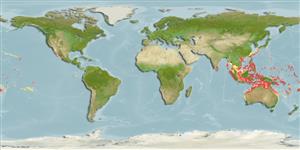>
Ovalentaria/misc (Various families in series Ovalentaria) >
Pseudochromidae (Dottybacks) > Pseudoplesiopinae
Etymology: Lubbockichthys: After Roger Lubbrock, Cambridge University; he died in Brazil in a car accident in 1981. He described and discovered many species in the Rea Sea in 1970 and early 80´s.
Environment: milieu / climate zone / depth range / distribution range
Ecología
marino asociado a arrecife; rango de profundidad 0 - 65 m (Ref. 30874), usually 0 - 20 m (Ref. 90102). Tropical
Indo-Pacific: eastern Indian Ocean to central Pacific.
Tamaño / Peso / Age
Maturity: Lm ? range ? - ? cm
Max length : 7.5 cm TL macho / no sexado; (Ref. 48635)
Short description
Morfología | Morfometría
Espinas dorsales (total): 2; Radios blandos dorsales (total): 25-26; Espinas anales 1-2; Radios blandos anales: 15 - 16. Appears pink underwater (Ref. 48635).
Occurs inshore (Ref. 7300), in crevices near drop-offs (Ref. 8631, 48635). Also found in caves (Ref 90102).
Life cycle and mating behavior
Madurez | Reproducción | Puesta | Huevos | Fecundidad | Larva
Randall, J.E., G.R. Allen and R.C. Steene, 1990. Fishes of the Great Barrier Reef and Coral Sea. University of Hawaii Press, Honolulu, Hawaii. 506 p. (Ref. 2334)
IUCN Red List Status (Ref. 130435)
Threat to humans
Harmless
Human uses
Acuario: Comercial
Más información
Age/SizeCrecimientoLength-weightLength-lengthLength-frequenciesMorfometríaMorfologíaLarvaDinámica larvariaReclutamientoAbundanciaBRUVS
ReferenciasAcuiculturaPerfil de acuiculturaRazasGenéticaElectrophoresesheritabilidadEnfermedadesProcesamientoNutrientsMass conversion
ColaboradoresImágenesStamps, Coins Misc.SonidosCiguateraVelocidadTipo de nataciónSuperficie branquialOtolitosCerebrosVisión
Herramientas
Special reports
Download XML
Fuentes de Internet
Estimates based on models
Preferred temperature (Ref.
123201): 24.9 - 29, mean 27.8 °C (based on 484 cells).
Phylogenetic diversity index (Ref.
82804): PD
50 = 0.6250 [Uniqueness, from 0.5 = low to 2.0 = high].
Bayesian length-weight: a=0.00389 (0.00180 - 0.00842), b=3.12 (2.94 - 3.30), in cm total length, based on all LWR estimates for this body shape (Ref.
93245).
Nivel trófico (Ref.
69278): 3.5 ±0.6 se; based on size and trophs of closest relatives
Fishing Vulnerability (Ref.
59153): Low vulnerability (10 of 100).
Nutrients (Ref.
124155): Calcium = 160 [82, 271] mg/100g; Iron = 0.841 [0.493, 1.424] mg/100g; Protein = 18.4 [17.3, 19.4] %; Omega3 = 0.121 [0.067, 0.216] g/100g; Selenium = 29.3 [13.1, 63.9] μg/100g; VitaminA = 144 [46, 441] μg/100g; Zinc = 1.99 [1.30, 2.87] mg/100g (wet weight);
